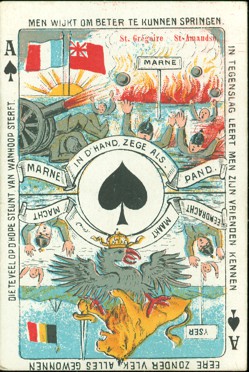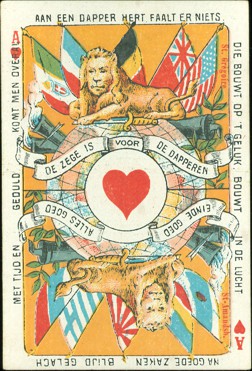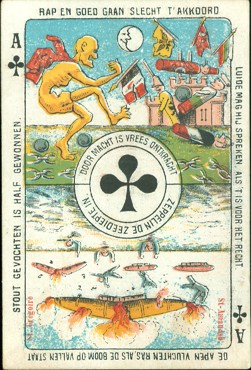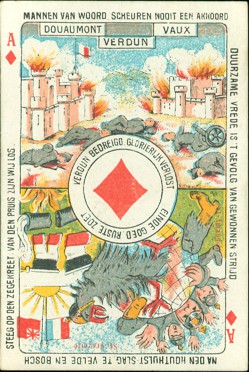June
2017
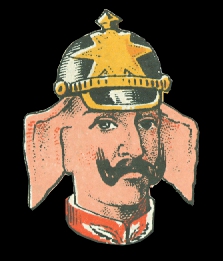 |
|
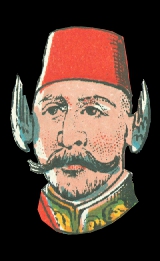 |
|
On
the 2nd we received an antique French deck that has been in the running
for this spot for a long time. Although Joop picked up a few new decks
during the Collectors Day at the Belgian National Playing Card Museum in
Turnhout, none of them made a chance to be shown here, but..... these
LOSERS here did! |
It was a bit of
a hectic month with lots of appointments with friends, so there wasn't much time
to spend at the pc. Still we did follow the offer on a few eBay's and the Dutch
auction sites. There was a nice antique French fortune telling deck (with suits,
A's-7's) but that still wasn't a real winner. However, on one of the Dutch
auction sites Joop discovered a rarely seen deck. A
good bid did the rest and because it was a Dutch auction site, it only took a
few days before the deck arrived in our mailbox. It was immediately chosen for
this spot!
We have a similar designed deck
(which can be seen in the "War
on Cards" xpo) but that deck has all texts in French. This version has
all texts in Flemish, which is very close to Dutch. The French (Walloon) version
is already a rarely seen deck, but somehow this Flemish version is even more
difficult to find. But we found that there are some other differences too. Our
French version has rounded corners and gilded edges all around, while this
Flemish version has square corners and no gilded edges. But there are some
differences on the pip cards too.
The deck was
lithographically printed by Leonard Biermans from Turnhout and published as "Jeu des Alliés"
in 1919. It was published to celebrate the victory over Germany and the end of
the Great War in November 1918. The designs are full of slogans, sayings and
comments and they reflect the commitment and gratitude, the sense of unity and the
relief, that the Belgians must have felt in the first months after the end of
the war. Belgium was struck hard in the southern part of the country, where a
harsh trench war was fought that has cost many young lives and of which farmers
still find the relics when they plough their land.
Just like in the
French version each of the courts cards and aces (a joker was never issued) has
slogans, sayings or comments along all sides. But there's plenty of small texts
to find on these cards too. We have made a comparison of the French and Flemish
texts and in general one can say that they are the same, with a few exceptions.
For instance on the King of Spades, where the French "Petite Belgique à
vous l'honneur" (Little Belgium honor is yours) is replaced by the Flemish
"Klein Belgie door den barbaar tot slaaf verwezen" (Little Belgium
enslaved by the barbarian").
Because some texts were set in rhyme, the translation sometimes needed to be
adapted a bit to rhyme in Flemish too. However, along the sides the texts have
sometimes changed place on the card and this has also happened with one text in
the design.
The texts were probably translated from French into Flemish by a translator with
little political knowledge. On the King of Spades one of the French lines says
"le président Wilson restera en renom". In the Flemish text this is
translated as "voorzitter Wilson zal benoemd blijven". The part where
Wilson will remain appointed (in office) was translated correctly, but Wilson
himself was demoted from President to Chairman. Another cute example is on the
Queen of Hearts. There "Le Japon" is translated into "Japonie".
I think that even in Flemish the correct name is Japan.
|
The Kings
and Queens show the "western" allies, the jacks Germany and
its allies. The Kings and Queens are designed like regular courts, only
the sash or robe is done in the national colors of the represented
country. However, the Jacks are more personal in design, like the German
emperor William II with his pig's ears in the spades suit or the German field Marshall
Von Hindenburg depicted as a joker in the clubs suit. |
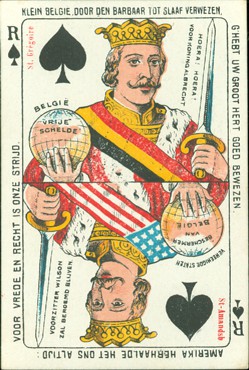 |
Rumania/Belgium
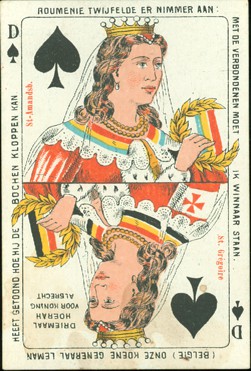 |

|
|
Belgium/USA |
Germany |
|
England |
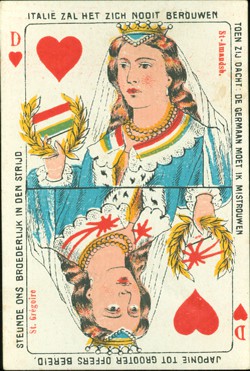
Italy/Japan
|
Bulgaria |
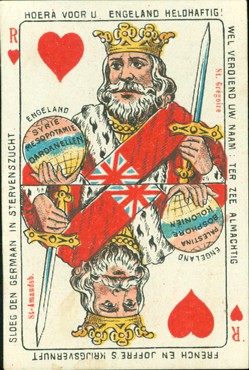 |
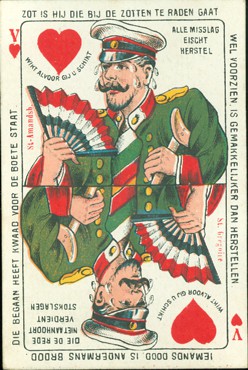
|
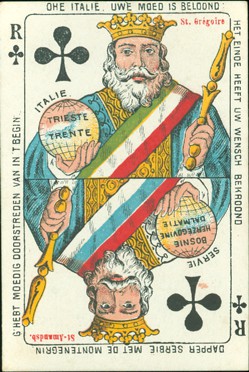 |
England/USA
 |
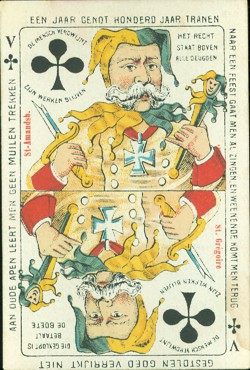
|
|
Italy/Serbia |
Germany |
|
Rumania/France |
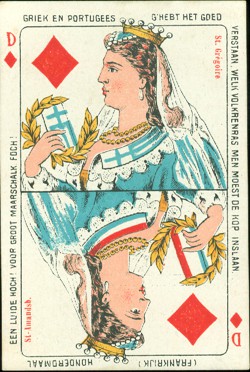
Greece/France
|
Turkey |
 |
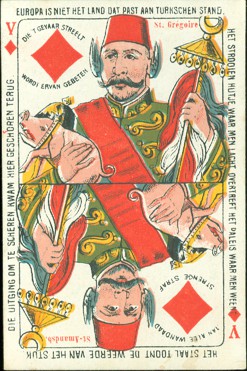
|
|
The
QD is dressed in the Greek colours, but in the text Portugal is mentioned
too as one of the allies. The text reads: "Greek and Portuguese you
have well understood which race of people one should bash the head
in." No subtlety here! |
There are a
few mysteries left to discuss. First a simple question: why would one use
French indices in a Flemish deck? But more mysterious are, printed in red, the names of St.
Grégoire and St-Amandsb. The latter was named Mt St-Amand in the French
version. It probably refers to a community, a suburb of Gent, called St.
Amandsberg (Mount St-Amand). We had hoped to find a similar answer for St.
Grégoire, but that reference didn't become clear. It's a village in France,
but so far away from where the frontline was, that it's hard to believe that
it has anything to do with this war. But here below is another puzzle.....
|
The
back design with swords and bombs has a remarkable detail: the "marque
déposée" shield, held by a lion. It's a sort of copyright
statement. The French as well as the Flemish version have the same back
design. The lion represents Belgium and
the slain German eagle at his feet speaks for itself. The initials,
which seem to have an R in front and an A and P in the back, can be read
in different order, but none of them gave a search result. It could be
that the initials belong to the artist who has designed the deck, but
also the initials of an organization that was involved in the
publication of the deck. Maybe our
Belgian friends have a clue..... |
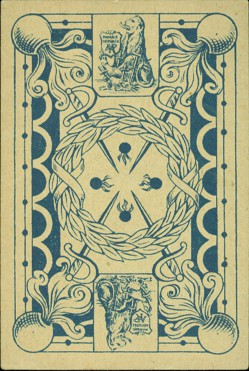 |

|
|
Sadly both our decks didn't come with the
original box. |
BACK
TO PRESENT MONTH








